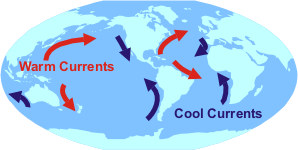|
Ocean Circulations
In January 1992, a container ship near the International Date Line, headed to Tacoma, Washington from Hong Kong, lost 12 containers during severe storm conditions. One of these containers held a shipment of 29,000 bathtub toys. Ten months later, the first of these plastic toys began to wash up onto the coast of Alaska. Driven by the wind and ocean currents, these toys continue to wash ashore during the next several years and some even drifted into the Atlantic Ocean.
The ultimate reason for the world's surface ocean currents is the sun. The heating of the earth by the sun has produced semi-permanent pressure centers near the surface. When wind blows over the ocean around these pressure centers, surface waves are generated by transferring some of the wind's energy, in the form of momentum, from the air to the water. This constant push on the surface of the ocean is the force that forms the surface currents.
Learning Lesson: How it is Currently Done
 Around the world, there are some similarities in the currents. For example, along the west coasts of the continents, the currents flow toward the equator in both hemispheres. These are called cold currents as they bring cool water from the poler regions into the topical regions. The cold current off the west coast of the United States is called the California Current. Around the world, there are some similarities in the currents. For example, along the west coasts of the continents, the currents flow toward the equator in both hemispheres. These are called cold currents as they bring cool water from the poler regions into the topical regions. The cold current off the west coast of the United States is called the California Current.
Likewise, the opposite is true as well. Along the east coasts of the continents, the currents flow from the equator toward the poles. There are called warm current as they bring the warm tropical water north. The Gulf Stream, off the southeast United States coast, is one of the strongest currents known anywhere in the world, with water speeds up to 3 mph (5 kph).
These currents have a huge impact on the long-term weather a location experiences. The overall climate of Norway and the Bristish Isle is about 18°F (10°C) warmer in the winter than other cites located at the same latitude due to the Gulf Stream.
Take it to the MAX! Keeping Current
While ocean currents are a shallow level circulations, there is global circulation which extends to the depths of the sea called the Great Ocean Conveyor. Also called the thermohaline circulation, it is driven by differences in the density of the sea water which is controlled by temperature (thermal) and salinity (haline).
In the northern Atlantic Ocean, as water flows north it cools considerably increasing its density. As it cools to the freezing point, sea ice forms with the "salts" extracted from the frozen water making the water below more dense. The very salty water sinks to the ocean floor.
Learning Lesson: That Sinking Feeling
It is not static, but a slowly southward flowing current. The route of the deep water flow is through the Atlantic Basin around South Africa and into the Indian Ocean and on past Australia into the Pacific Ocean Basin.
If the water is sinking in the North Atlantic Ocean then it must rise somewhere else. This upwelling is relatively widepsread. However, water samples taken around the world indicate that most of the upwelling takes place in the North Pacitic Ocean.
It is estimated that once the water sinks in the North Atlantic Ocean that it takes 1,000-1,200 years before that deep, salty bottom water rises to the upper levels of the ocean.
The Great Ocean Conveyor
 |
|





